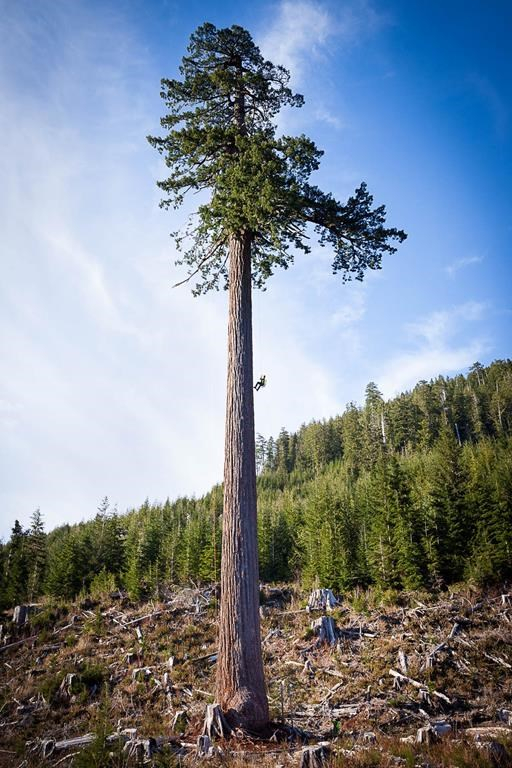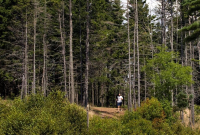Support strong Canadian climate journalism for 2025
The British Columbia government is protecting 54 of the province's largest and oldest trees along with a one-hectare buffer zone surrounding each of the giants.
Forests Minister Doug Donaldson said Wednesday that the announcement is also the start of a broader conversation about the future of old-growth management in the province.
The trees are on the University of B.C.'s Big Tree Registry that has identified 347 of the largest of each species in the province.
The 54 trees were at risk of being harvested, but now the government says they'll be protected.
"These trees represent an important part of B.C.'s natural heritage, and British Columbians have said they want them preserved," Donaldson said.
Ira Sutherland, the chair of the Big Tree committee, said they're happy to see any of the trees being protected, but the number announced seems small.
"What we were hoping for is a policy to protect all big trees above a certain size so that we were to make sure that big trees are protected throughout B.C.," he said in an interview.
Sutherland, whose research as a PhD student at UBC looks at the values provided by old-growth forests, said the forests store huge amounts of carbon to regulate climate, they provide critical habitat for endangered species and have cultural and social values.
He said entering such a forest makes you feel tiny.
"Just being surrounded by these organisms that are hundreds or thousands of years old and are several hundred times bigger than yourself, it just really humbles you," he said. "The light comes in like a stained glass window in a cathedral or something. It's just an incredible environment that really resonates with people."
The 54 trees to be protected are located in more than two dozen locations, including central B.C., the East Kootenays, Haida Gwaii, Vancouver Island and the Fraser Valley.
The species include arbutus, coastal Douglas fir, Pacific yew, ponderosa pine, Sitka spruce, western red cedar and western white pine.
Sally Aitken, the UBC co-ordinator for the Big Tree Registry, said it's good that the government protected not just the individual trees, but the forests surrounding the giants.
"However, protecting these individuals within a one-hectare patch of forest is not a replacement for the comprehensive protection of intact old-growth ecosystems," she said in an emailed statement.
Starting this fall, an independent two-person panel will meet with First Nations, industry and communities on how to manage old growth in the province, the government said in a news release.
Currently, 55 per cent of old-growth forests on Crown land in B.C.'s coastal region are already protected from logging.
Size thresholds for protection are set by government at 50 per cent of the largest tree on record for Douglas fir, Sitka spruce, western red cedar and yellow cedar and 75 per cent for all other species.
For example, the largest known coastal Douglas fir has been measured at 4.23 metres, or almost 14 feet, in diameter so trees would have to be at least 2.12 metres in diameter to be considered.
Aitken said the 75 per cent cut off for the other species would protect very few trees on the registry.
Ken Wu, executive director of the group Endangered Ecosystems Alliance, said it's a small step forward on saving B.C.'s old-growth ecosystems.
"Just as we have laws to protect 100-year-old heritage buildings, it makes sense to protect our biggest and oldest 500 or 1,000-year-old heritage trees," he said in a release.





Comments
I live on Vancouver Island. The devastation of Old Growth that the NDP government - Mr Donaldson, Forestry Minister, Mr Horgan, Premier and Ronna-Rae Leonard, my local MLA - continues to support is a sin. Fifty-four trees...I'd laugh, if I weren't crying. The government in Victoria needs to institute an immediate moratorium on ALL logging on the Island and the lower mainland and coast. Until you see what BC Timber Sales and private owners - like Timber West (now Mosaic) - are doing to Beautiful, Natural British Columbia, you can't imagine it.
And I want to add how disappointed I am in National Observer for just reprinting an apologist article that doesn't come anywhere close to the investigative standards I expect from you. The line about 55% of BC's old-growth forests being protected is misleading. The amount of productive, viable old-growth that is left is around 10%. The BC government is putting out this 55% figure, but it is so misleading as to qualify as disinformation. In around 100 years, BC has allowed the slaughter of around 90% of viable, healthy old-growth trees. It's not like these ancient giants grow back quickly. This is not a renewable resource in any human timeframe. When it takes 250 years to get to the designation of being "old" that is a time scale outside human experience. With only 10% of these healthy, viable ancients left, protecting 54 trees is an insult. Even with their one-hectare buffer, 54 hectares scattered around BC is less than two-thirds of Beacon Hill Park in Victoria. Just think about that! We need these ancient forests left intact - the 10% that still exists. We need a moratorium on old-growth logging IMMEDIATELY. Put loggers to work strengthening the forests. Those jobs are more long-term than cutting down trees. We need those healthy forests to help us fight the climate emergency. Come on, National Observer. I expect better from you. That's why I pay for a subscription - because I expect better.
How about protecting not only single trees, but a significant designated radius around them.
The mountains around my hometown have been denuded. I was stunned to realize that between government and "big logging," they hadn't even the decency to "protect" the visible surrounds of the village.
As a youngster, I walked along an old "Indian" trail to school, between gigantic cottonwood trees. They were all razed to the ground when the riverbed was bulldozed to prevent logjams. The benefit was said to be to prevent flooding.
Guess what happened. The logged-off hills no longer absorbed the spring snow melt, and there were no trees left for cover from the sun, so it all went at once. From here in Toronto one morning, I saw on TV news footage of someone motor-boating through my parents' flooded front yard. The last time I was there in spring, 2002, there was another flood. Despite the sump pumps that had kept the basement dry for 30 years, the basement took on almost a foot of water.
Climate change had already come to the mountain valley village by 1990: no more did snow come to stay the week around the calendar changing Oct to Nov. I was there in mid-December, and still no snow. Let alone snow to stay. The wild flowers had changed, as well.
Old-growth forests are very important to any fight against climate change, as well as to making coastal waters able to support healthy marine life.
When I flew up island to visit family in the mid-late 70s, there was a nice, healthy green corridor along the highways. The rest was a maze of logging roads and clearcuts.
In the late 60s, I planted trees in areas that had been burned by forest fires. They were single-species plantations.
Wherever virgin forests remain intact, the whole darned thing needs to be protected. And logging companies should be required to replant the same mix of species that existed before they began cutting. Anything else is ecologically irresponsible.
In Ontario, after the normal diameter trees were all gone, the government let licenses for small timber harvesting. I haven't been "up there" to see how things are now. But it's safe to bet any reforestation will have been with the species the logging companies want to harvest.
I agree, saving a few big trees is a pathetically inadequate response to the situation. Neither will a few old trees standing alone provide usable habitat for wild life.
And people wonder why they have cougars stalking the roof ridges of homes, carrying away small pets, attacking people driving motor-cycles down the highway to work. And they believe the bears prefer the garbage dump and ranch animals to their native habitat. Were that so, they'd have been plentiful in the 50s and 60s, when I still lived there.